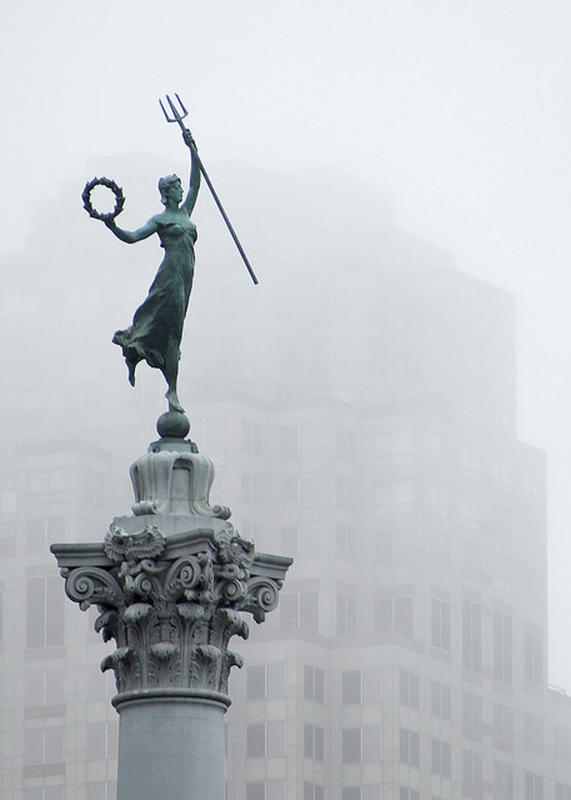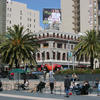More about Dewey Monument

Contributor
Big Alma Spreckels posed as Victoria, goddess of victory, and stands in the middle of Union Square in San Francisco.
Don't expect too close a look, she's on top of a 79-foot-tall granite pillar, and then an 18-foot-high pedestal. That's about 6 stories high! It's a miracle then that the statue, and Mrs. Spreckels, survived the Great Quake of 1906, which flattened large parts of the city and is believed to have killed over 3,000 people. More than half of the city's population was left homeless.
Spreckels went on to create the Legion of Honor, sister museum to the de Young, in San Francisco. Her likeness, goddess Victoria, to this day celebrates Admiral George Dewey's defeat of the Spanish fleet at Manila Bay, the Philippines, as the U.S. pried Cuba out of Spanish hands. (The U.S. first tried to buy Cuba from Spain but that went nowhere.)
The Spanish-American War of 1898 led to some kind of independence for Cuba, minus Guantanamo Bay. George W. Bush would use this bit of Cuba after the 2001 terror attack on the Twin Towers in New York to prevent suspected and real terrorists from having to be tried on American soil. Leading to the question...victories for whom?
Featured Content
Here is what Wikipedia says about Dewey Monument

The Dewey Monument is a memorial statue by Robert Ingersoll Aitken in San Francisco, California, located at the center of Union Square. Union Square is bounded by Geary, Powell, Post and Stockton Streets. The monument is dedicated to Admiral George Dewey and commemorates his victory in the Battle of Manila Bay during the Spanish–American War. Work on the monument began in 1901 and it was dedicated in 1903.
Check out the full Wikipedia article about Dewey Monument













The Dewey Monument is a memorial dedicated to Admiral George Dewey, who played a significant role in the Spanish-American War winning the Battle of Manila Bay, and President William McKinley, who was abruptly assassinated after breaking ground for the monument. When researching the Dewey Monument, the figure on top is often called “Winged Victory,” making it seem like there are two parts to the monument, the figure and the pillar.
For the figure, I enjoy looking at the sculpture of Nike, the Greek goddess of victory. The posing is fluid and balanced, with a trident in her left and a wreath in her right to represent Dewey and McKinley, respectively. The trident is often associated with the Greek god Poseidon or the roman Neptune, both sea deities. The wreath is associated with the Greek god Apollo, and it represents victory or glory. The dress she wears is being swept away in the wind and wrapped in a way that alludes to a Greek Chiton. The overall movement and posing make Nike angelic looking.
To continue, while this picture does not show it, the statue is placed on a large granite pillar, roughly standing over 85 feet and is over 5 ft in diameter. On top, the pillar is engraved with seahorses, waves, swirls, and imagery representing the sea, a callback to the dedication to Admiral George Dewey. However, I find it most interesting that on top of that, right beneath Nike’s feet, it seems to be an engraved fountain. I enjoyed that because there is extravagant carving beneath, all representing the bay, but, on top of it is a well-known and straightforward imagery of a fountain, something we can see almost anywhere, unlike a bay.
Overall, the Dewey Monument screams neoclassical to me. All elements point back to the classical world for inspiration from the Greek goddess Nike herself, what she holds, her dress, and the pillar she stands on.